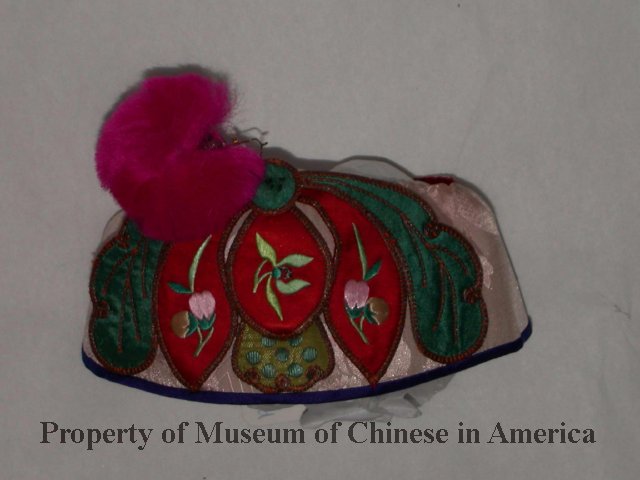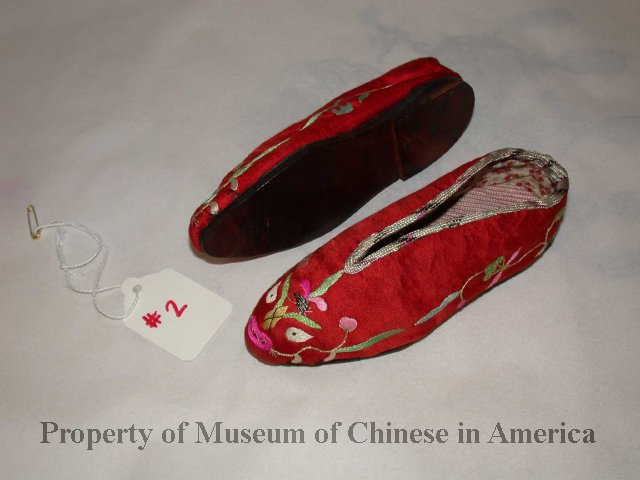Embroidery has long been a common folk art in China, and children’s clothing were often decorated with auspicious symbolic designs meant to invoke good fortune; ward off evil; and convey mothers’ wishes and moral teachings to children. Ethnographic research into symbolism in Chinese folk arts conducted by Christi Lan Lin and Phylis Lan Lin shed particular light on the meanings of the decorative motifs lovingly stitched onto the traditional Chinese children’s hat and shoes shown here. On this mandarin cap topped with a bright fuchsia pom, the embroidered lotus signified purity and perfection, the peach longevity and immortality, and the wan (卍 a Buddhist sign often confused for a swastika) a reinforcement of the mother’s wish for her child’s longevity. The creature on this tiny pair of red silk slippers is a bit ambiguous but could be a dragon or fish. Dragons in Chinese culture were emblematic of imperial authority and male vigor, and fishes, in Chinese a homonym for yu (余), represented abundance. These embroidering practices developed when rates of childhood mortality were high and children were perceived to require an extra layer of supernatural protection but continue to adorn children’s traditional special occasion attire to this day.
Collections馆藏Collections馆藏Collections馆藏Collections馆藏Collections馆藏Collections馆藏Collections馆藏Collections馆藏Collections馆藏Collections馆藏Collections馆藏Collections馆藏Collections馆藏Collections馆藏Collections馆藏Collections馆藏Collections馆藏Collections馆藏Collections馆藏Collections馆藏Collections馆藏Collections馆藏Collections馆藏Collections馆藏Collections馆藏Collections馆藏Collections馆藏Collections馆藏Collections馆藏Collections馆藏Collections馆藏Collections馆藏Collections馆藏Collections馆藏Collections馆藏Collections馆藏Collections馆藏Collections馆藏Collections馆藏Collections馆藏Collections馆藏Collections馆藏Collections馆藏Collections馆藏Collections馆藏Collections馆藏Collections馆藏Collections馆藏Collections馆藏Collections馆藏Collections馆藏Collections馆藏Collections馆藏Collections馆藏Collections馆藏Collections馆藏Collections馆藏Collections馆藏Collections馆藏Collections馆藏Collections馆藏Collections馆藏Collections馆藏Collections馆藏
Supernatural Clothing: The Power of Symbolic Imagery in Chinese Children’s Wear

1995.001.003 Pink silk children’s headband with colorful lotus flower embroidery at front. Red cotton lining; blue trim at top; hot pink pompom connected to bottom of lotus embroidery by metal wire. Elastic band at bottom of headband. Courtesy of Lily Hou, Museum of Chinese in America (MOCA) Collection.
粉红色丝绸儿童头带,正面饰有彩色莲花刺绣。红色棉衬里;顶部有蓝色饰边;粉红色绒球通过金属线连接到莲花刺绣的底部。头带底部有松紧带。Lily Hou捐赠,美国华人博物馆 (MOCA) 馆藏。

1995.001.001 Silk embroidered children's shoes in red with leather soles. Piping along opening. Chinese painted on bottom heel of right shoe in black. Creature's face embroidered at toes. Courtesy of Lily Hou, Museum of Chinese in America (MOCA) Collection.
红色真丝刺绣童鞋,皮革鞋底。沿开口配管。黑色右鞋后跟处绘有中国字。脚趾上绣着怪物的脸。Lily Hou捐赠,美国华人博物馆 (MOCA) 馆藏。